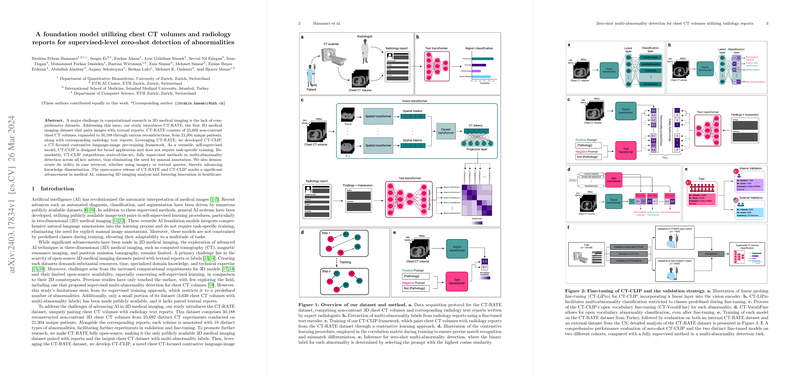Leveraging CT-RATE and CT-CLIP for Advanced Multi-Abnormality Detection in Chest CT Volumes
Introduction to CT-RATE and CT-CLIP
The paper introduces CT-RATE, a pioneering dataset pairing non-contrast chest CT volumes with corresponding radiological text reports, and CT-CLIP, a contrastive language-image pre-training framework optimized for this dataset. CT-RATE encompasses 25,692 CT volumes (expanded to 50,188 through reconstructions) from 21,304 unique patients. CT-CLIP, leveraging the dataset, establishes a new benchmark in multi-abnormality detection in chest CT scans by outperforming fully supervised methods without necessitating manual annotation.
CT-RATE Dataset: A Novel Resource
CT-RATE stands as the first comprehensive 3D medical imaging dataset that merges images with textual radiology reports. The significance of this dataset lies in its ability to facilitate the training of more sophisticated models capable of understanding the complex interplay between visual features and textual descriptions in medical imaging. This advancement addresses a critical gap in available datasets for computational research in 3D medical imaging.
CT-CLIP: Setting New Standards
CT-CLIP, developed on the CT-RATE dataset, demonstrates remarkable capabilities in zero-shot multi-abnormality detection. The model achieves superior performance across all key metrics when compared to state-of-the-art, fully supervised methods. Its achievements can be summarized as follows:
- Outperforms fully supervised approaches in multi-abnormality detection without requiring task-specific training.
- Shows utility in case retrieval for both imagery and textual queries, thus promoting a more efficient dissemination of medical knowledge.
- The open-source availability of CT-CLIP and the CT-RATE dataset is poised to significantly advance medical AI by enhancing the analysis of 3D imaging and fostering innovation in healthcare applications.
Implications and Future Directions
The development of CT-CLIP and the presentation of the CT-RATE dataset have several important implications:
- Reduction of Manual Annotation Effort: The ability of CT-CLIP to exceed the performance of supervised methods in detecting multiple abnormalities demonstrates a critical step towards reducing the reliance on labor-intensive manual annotations in medical imaging.
- Advancement in Case Retrieval: The efficacy of CT-CLIP in retrieving cases using both image-based and text-based queries can significantly expedite the review of relevant past cases, potentially improving diagnostic accuracy and patient care.
- Foundation for Future Research: The release of CT-RATE is set to catalyze further research in medical imaging analysis. Future work could explore extending CT-CLIP's capabilities to other imaging modalities or to more granular abnormality detection and classification tasks.
Conclusion
The introduction of CT-RATE and CT-CLIP represents a significant step forward in the computational analysis of medical imaging, specifically in the context of chest CT scans. By achieving unprecedented performance in multi-abnormality detection and facilitating efficient case retrieval, this work sets a new benchmark in the field. Looking ahead, the potential applications of this research in improving diagnostic workflows and patient outcomes are vast, with the open-source release ensuring broad accessibility and encouraging continued innovation in medical AI research.
